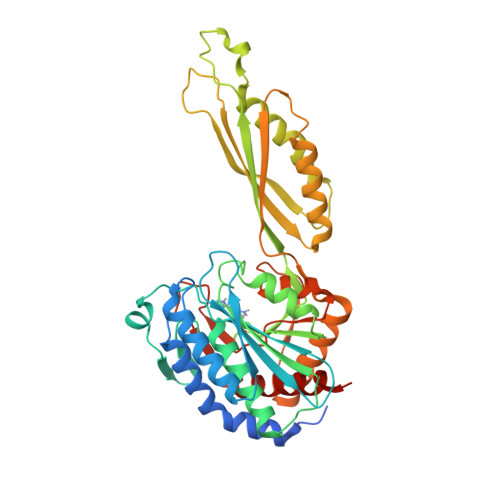A Bis(imidazole)-based cysteine labeling tool for metalloprotein assembly.
Ahmad, R., Tyryshkin, A.M., Xie, L., Hansen, W.A., Yachnin, B.J., Emge, T.J., Mashrai, A., Khare, S.D., Knapp, S.(2023) J Inorg Biochem 244: 112206-112206
- PubMed: 37030124
- DOI: https://doi.org/10.1016/j.jinorgbio.2023.112206
- Primary Citation of Related Structures:
6XJ5 - PubMed Abstract:
Precise metal-protein coordination by design remains a considerable challenge. Polydentate, high-metal-affinity protein modifications, both chemical and recombinant, can enable metal localization. However, these constructs are often bulky, conformationally and stereochemically ill-defined, or coordinately saturated. Here, we expand the biomolecular metal-coordination toolbox with the irreversible attachment to cysteine of bis(1-methylimidazol-2-yl)ethene ("BMIE"), which generates a compact imidazole-based metal-coordinating ligand. Conjugate additions of small-molecule thiols (thiocresol and N-Boc-Cys) with BMIE confirm general thiol reactivity. The BMIE adducts are shown to complex the divalent metal ions Cu ++ and Zn ++ in bidentate (N 2 ) and tridentate (N 2 S*) coordination geometries. Cysteine-targeted BMIE modification (>90% yield at pH 8.0) of a model protein, the S203C variant of carboxypeptidase G2 (CPG2), measured with ESI-MS, confirms its utility as a site-selective bioconjugation method. ICP-MS analysis confirms mono-metallation of the BMIE-modified CPG2 protein with Zn ++ , Cu ++ , and Co ++ . EPR characterization of the BMIE-modified CPG2 protein reveals the structural details of the site selective 1:1 BMIE-Cu ++ coordination and symmetric tetragonal geometry under physiological conditions and in the presence of various competing and exchangeable ligands (H 2 O/HO - , tris, and phenanthroline). An X-ray protein crystal structure of BMIE-modified CPG2-S203C demonstrates that the BMIE modification is minimally disruptive to the overall protein structure, including the carboxypeptidase active sites, although Zn ++ metalation could not be conclusively discerned at the resolution obtained. The carboxypeptidase catalytic activity of BMIE-modified CPG2-S203C was also assayed and found to be minimally affected. These features, combined with ease of attachment, define the new BMIE-based ligation as a versatile metalloprotein design tool, and enable future catalytic and structural applications.
- Department of Chemistry & Chemical Biology, Rutgers The State University of New Jersey, 123 Bevier Rd, Piscataway, NJ 08854, United States of America.
Organizational Affiliation:




















